In the past year, the city of Emmen in the Netherlands has experienced something interesting: a new sense of pride and appreciation for its city centre has arisen in both its inhabitants as well as its visitors. The relocation of its zoo and, as a consequence, a complete renewal of a large part of the city centre have not only resulted in a number of prize winning projects but also in an expansion and new interpretation of the easy going, leisurely atmosphere that has characterised the city centre for the last few decades.
Unlike many planned new towns, often displaying homogenous residential expansion areas, Emmen has managed to keep its leisurely, village-like, almost personal feeling intact. Emmen, a mid-sized city in the north-east of The Netherlands, expanded rapidly in the post-World War II era. New companies not only demanded cheap labour and good housing but also sporting, cultural and recreational facilities for their employees.
To accommodate these wishes and to position Emmen as a pleasant place to reside, urbanists Niek de Boer and Andre de Jong developed their concept of ‘Open Green City’ in the 1960s. The new expansions were all based on masterplans combining modern housing with a rural setting and a spacious urban layout. Instead of developing a traditional city centre with surrounding residential quarters, Emmen’s growth is based on a structure of autonomous, largely self-sufficient neighbourhoods, all divided by landscape elements, forests, agricultural lands and extensive green structures. In its own way, each new neighbourhood is based on the principles of ‘Open Green City’; integrating housing areas intimately with green and water structures to facilitate sports and recreational use.
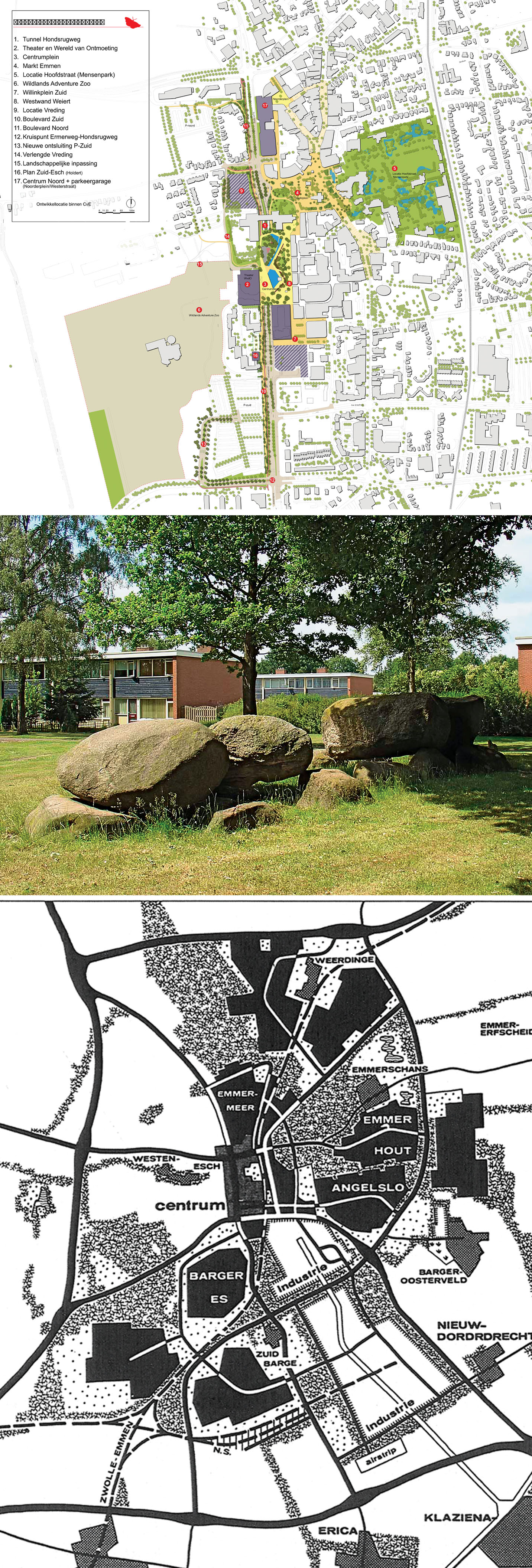
Middle: The post World War II expansions were all based on masterplans combining modern housing with a rural setting and a spacious urban layout
Bottom: Masterplan for Emmen ‘Open Green City’ from the 1960’s displaying a series of autonomous expansion areas separated by large green structures
Emmen’s city centre has not been the subject of any overarching masterplan. Nevertheless, key characteristics, providing the planned neighbourhoods with a leisurely living environment, can also be found in the structure and appearance of the city centre: its urban DNA. A combination of these characteristics has given the centre its natural, easygoing, pleasant and even nonchalant identity.
Firstly, the geographical setting – directly bordering the agricultural lands to the west and directly bordering the forest Emmerdennen to the east – not only provides a stark contrast between the built-up area and the adjacent nature, but also draws this natural setting directly into the city centre. Recreational walking and cycling routes and the vicinity of a number of hunebeds (pre-historical artefacts) guide tourists through to the city centre.
Secondly, the focus on expansion of the city centre into surrounding open areas generally meant that the need for large-scale redevelopment of the original village build-up was unnecessary. Over the years, architecture changed, streets with adjacent front gardens were pedestrianised to create shopping streets and (re-) developments occurred. However, the original village structure, spacious streets, predominantly low-rise buildings and the green, open atmosphere remained. This spacious layout allows for a carefree mix of pedestrians, cyclists and cars, residents and tourists.
Unlike many planned new towns, often displaying homogenous residential expansion areas, Emmen has managed to keep its leisurely, village-like, almost personal feeling intact
Thirdly, Emmen’s identity is undisputedly related to its zoo. Opened in 1935, in the backyard of his parental house at the Market, founder W. Oosting started a zoo that was going to grow into one of the most famous tourist attractions in Netherlands. The zoo, a lush green area of 12 hectares, combining centuries-old linear tree structures with organic and themed landscaping, is situated in the heart of the city centre and has attracted ample tourists to the city centre over the last 80 years. It also hosts leisure and cultural events and has a green background for the shopping areas.
Due to its physical boundaries in relation to the need for innovation and expansion, the zoo started developing a second location, just to the west of the centre, eventually resulting in the relocation of the entire zoo towards the edge of the city centre. In April 2016, Wildlands Adventure Zoo, Emmen, opened its gates to welcome an estimated 1.3 million visitors each year. Wildlands displays a completely new concept of zoo, taking visitors on an expedition through the animals’ habitats in combination with theme-park attractions.
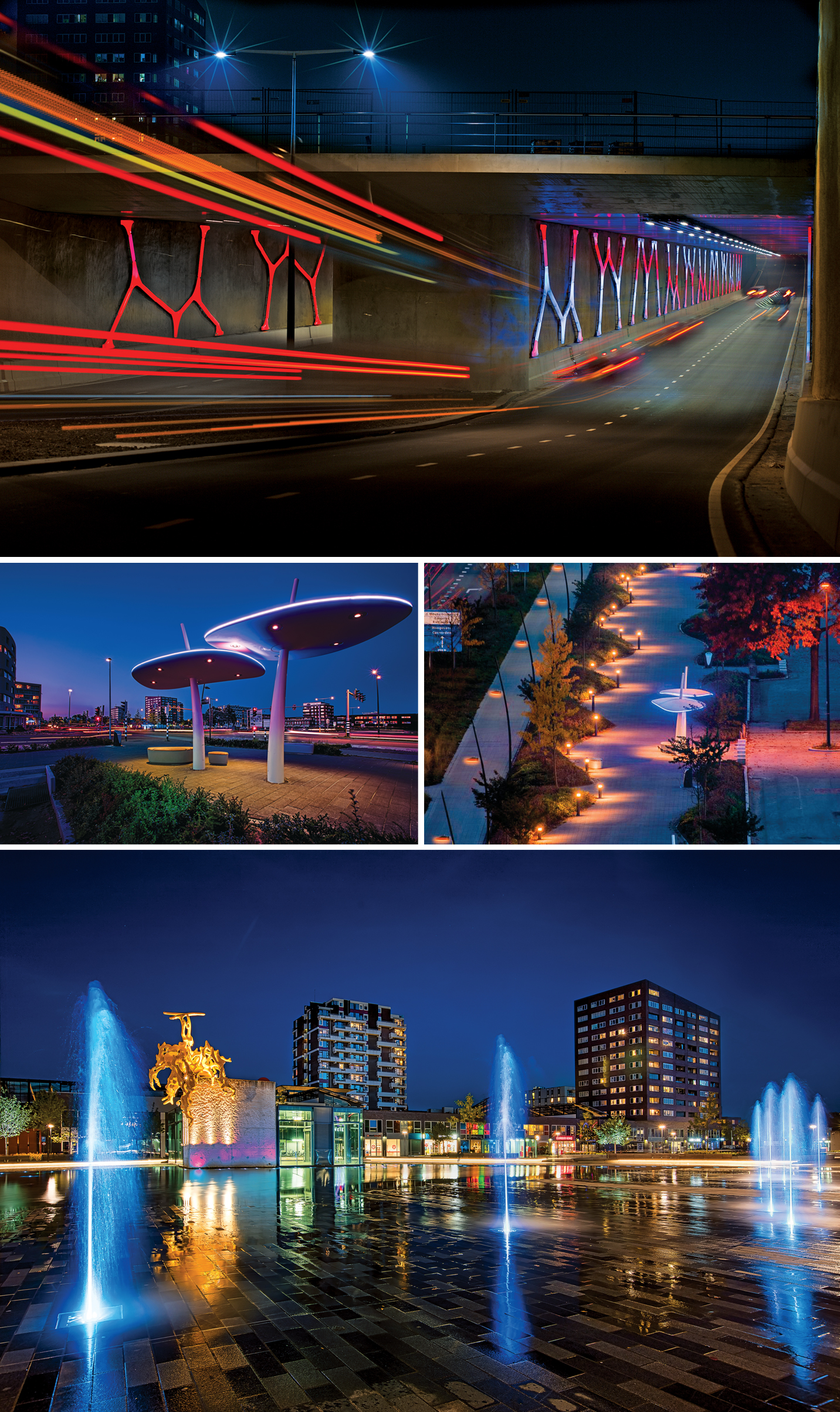
Middle Left & Right: New pedestrian routes alongside the Hondsrugweg
Right: A comprehensive lighting scheme improves the quality of the public realm
Since 2007, the Municipality of Emmen has been working on the integral development of a large part of its city centre. Relocating the zoo towards the edge of the centre not only created the opportunity to redevelop the former zoo (12 hectares of high quality landscaped terrain right in the heart of the city), but also provided a challenge in linking Wildlands with the existing city centre. The programme ‘Centrum Vernieuwing Emmen (City Renewal Emmen)’ therefore formed a combination of infrastructural, architectural, urban design and landscaping projects to accommodate the logistic changes in the urban structure and the self-evidence of the connection between old and new.
Between 2012 and 2016, Emmen’s city centre has changed significantly. A new theatre was developed, adjoining the entrance to Wildlands, resulting in a grand building defining the edge of the centre. With a strong curve-gesture, the vegetation roof conceals the large stage tower and covers the clean white and transparent building under a ‘green cloak’.
Emmen’s identity is undisputedly related to its zoo
The Hondsrugweg, the main through-route in the centre, has been tunneled to provide a smooth, on-ground level expansion of the city centre. In the tunnel, a prize-winning lighting sculpture, spanning a length of 1000 metres, displays motifs of glacial rocks found in this part of Netherlands.
Alongside the Hondsrugweg, new pedestrian routes have been laid out. In a concise but playful way, a curvy footpath, bordered by a tapestry hedge, guides visitors from the main carparks towards the city centre. An arty shelter with a leaf-shaped roof and footstool-like seating elements, functions as a waymaker along the route every few hundred metres.
Above the Hondsrugweg tunnel there’s a new public space, the Raadhuisplein. It’s located in the middle between the Wildlands and the theatre on the west and the shopping centre and market square on the east. German landscape architects Latz&Partner designed a scheme that is both place and park. Following Emmen’s tradition of urban build-up with landscape bordering it, the new Raadhuisplein combines urban hardscape with the natural softscape of the adjacent agricultural land, bringing the city towards the new theatre and drawing in the surrounding landscape. A strong diagonal water basin guides pedestrians and cyclists towards the market square, the heart of the city centre. The sheer size of the square combined with urban playing facilities (skate park and playground) in a green setting, water features in a stoney setting and a curving 150-metre long wooden sundeck creates a new type of urbanity, complementary to Emmen’s identity. A mixture of strolling tourists and residents, people relaxing on the sundeck, family picnics, children in bathing suits playing in the water basin, as well as young people showing off at the skate ramp provide constant recreational activity in a leisurely yet urban surrounding.
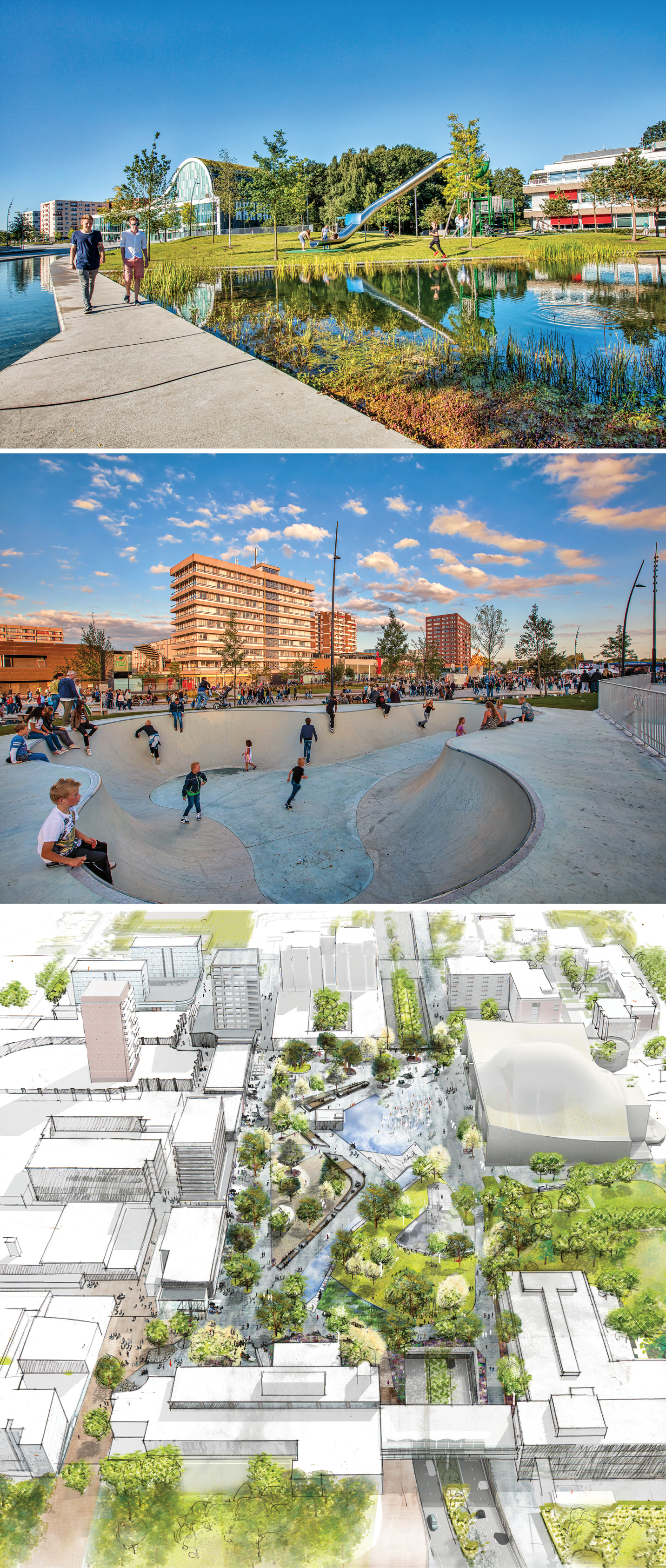
Middle: Outdoor activities in the public realm provide constant recreational activity in a leisurely yet urban surrounding
Bottom: The Raadhuisplein, forms the intermediate between Wildlands and theatre on the westside and the shopping centre and market square on the eastside. German landscape architects Latz&Partner designed a scheme that is both place and park
The market square has been redesigned to complete linking existing and new parts of the centre. Matching pavement material interconnects both squares and provides the market with a contemporary design. Again, a mixture of spacious layout, centuries-old trees, a playground in a green setting and adjacent bars and restaurants creates an informal and pleasant atmosphere.
As an overall theme, a comprehensive lighting scheme has been integrated in all projects. This not only improves the quality of the public realm during night time, but also addresses the key characteristic elements of the public realm such as trees, sculptures, water features and the grand sundeck in the middle of the Raadhuisplein. The overall scheme recently won the City.People.Light Award 2016, but, more importantly, it lengthens people’s visit to the city centre, positively influencing the food service industry. “A good city is like a good party: people stay longer than really necessary, because they are enjoying themselves,” rightly said Danish urbanist Jan Gehl.
The CVE (Centrum Vernieuwing Emmen) projects have resulted in a tremendous impetus to the quality of the public realm. Mostly enhancing existing characteristics and features, but also introducing new design elements influenced by the existing context, the projects create places that appeal to all strata of society, making them functional and attractive.
Since the completion of the Raadhuisplein, the place has been in use throughout the day no matter what the season. It has been embraced by the general public to linger, to play and to hang out. The development of new cafes, resulting in an architectural upgrade of surrounding buildings, has enabled this new place to fit into the urban pattern. Setting the bar high in terms of design quality has paid off well. The easy-going, leisurely atmosphere that characterises the existing city has been expanded with a new contemporary, more urban interpretation.
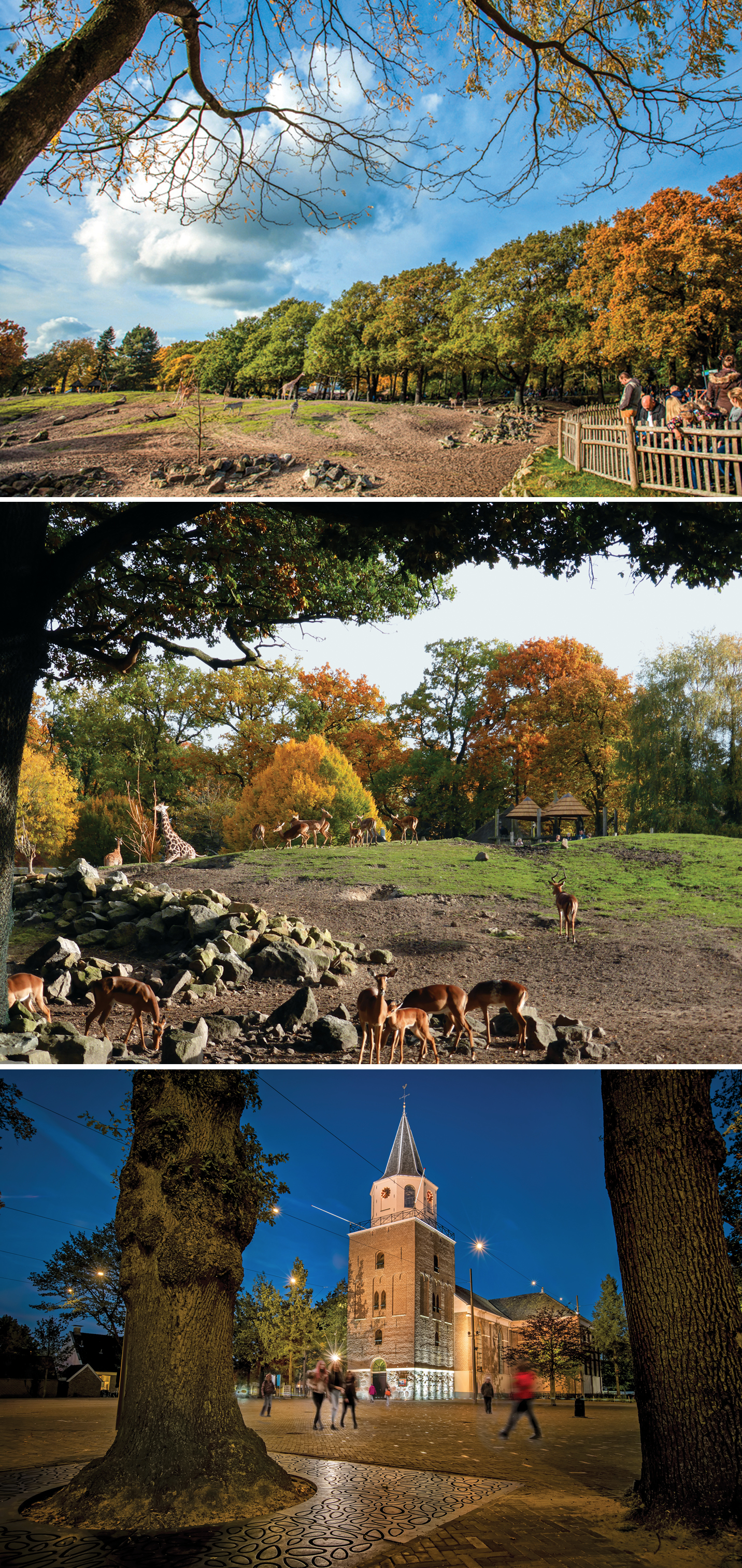
Bottom: A new contemporary design connects the Market square with Raadhuisplein. A mixture of spacious layout, centuries old trees, a playground in a green setting and adjacent bars and restaurants create an informal and pleasant atmosphere
Whilst the programme ‘Centrum Vernieuwing Emmen’ is almost complete, Emmen faces new challenges. Like many cities in the Netherlands, Emmen is dealing with a significant reduction in stores. Due to changing retail habits, competition from online shopping, global economic recession and bankruptcy of major store chains, empty shop windows and vacancies throughout the city centre are common. This results in blind spots in the main shopping area and main streets losing both their retail function and their prominent appearance, exaggerating even more the contrast in quality between the new and existing parts of the city centre.
Currently, Emmen is searching for answers on how to keep its city centre lively and economically viable. Two developments are essential in facing these challenges: a new strategic plan for the city centre and the redevelopment of the former zoo area. A new Strategic Plan for the city centre is currently under development. In co-creation with key stakeholders such as retailers, hotel and restaurant services, real estate developers and residents, a new spatial and economical vision for the city centre is being drafted. The essence of the plan is to concentrate retail uses in a more compact central area. Completed with more housing and a larger variety of urban uses, the future centre will host a lively and denser mix of functions and people.
Furthermore, Emmen has learned from recent successes of investing in public realm. Quantity is now being replaced by quality. Based on a strong belief in building further on its intrinsic strengths and identity, the strategic plan focuses on enhancing the attractive green atmosphere, outdoor activities, recreation facilities, culture and leisurely setting to reinforce the changing shopping areas.
Currently, Emmen is searching for answers on how to keep its city centre lively and economically viable
Also, the redevelopment of the former zoo can be of significant influence to Emmen. Establishing new types of uses and activities, complementing its function as a regional centre, will give Emmen a stronger position in the Northern part of the Netherlands.
Using the phrase ‘from animal park to people park’, the council has drafted a concept for redeveloping the zoo into an area of culture, creativity and innovation. The central area, the Savanna, once home to elephants, rhinos and giraffes, will be transformed into a park; a lush green expansion of the adjacent market square. Many characteristics of the zoo’s landscape will be retained providing an adventurous background for urban sports, recreation, festivals and outdoor theatre.
Surrounding the park, various zones have been identified to accommodate new developments in a park-like setting. Innovative hotel and short-stay accommodation will benefit from the unique setting, keeping visitors in the centre. The zone directly between the park and market, containing three monumental buildings, will be transformed into a culture and creativity quarter. Set directly in the city centre this new park and quarter will add a new dimension to Emmen’s identity in the coming years.
It seems that Emmen manages to pursue its strong tradition in entangling nature and built-up area in its deliberately designed neighbourhoods and its rediscovered city centre that has been reinforced and redesigned. A greater awareness of its own strengths and its own urban DNA has resulted in the consistent use of characteristics such as ‘natural’, ‘casual’, ‘spacious’ and ‘easygoing’ as valuable design aspects. If Emmen keeps on building on these aspects, the leisurely atmosphere that has characterised the city centre for the last decades will also lead to Emmen’s prosperity in the decades to come.
The author has taken utmost care and effort not to violate copyright of third person.
All Photographs: Eugene Sauren

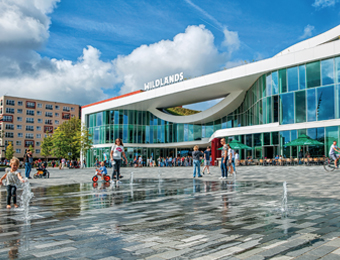

Comments (0)